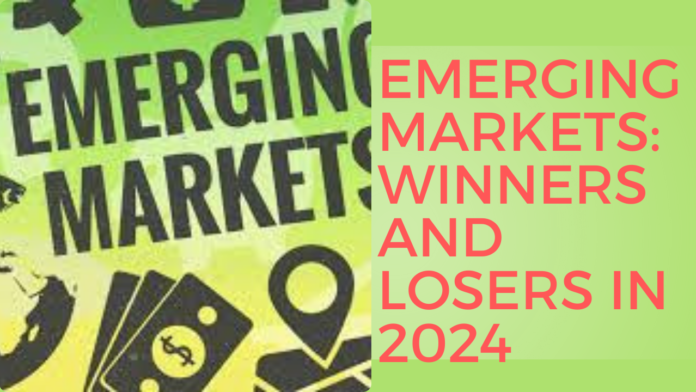Introduction to Emerging Markets
Emerging markets are capturing the attention of investors and analysts alike as we venture into 2024. With a diverse blend of growth potential, cultural richness, and untapped resources, these regions are often seen as the next big opportunity in global finance. But which countries will lead the charge? And who might struggle amidst shifting economic tides?
The MSCI Emerging Markets Index serves as a beacon for investors looking to maximize returns while navigating this complex landscape. From Southeast Asia’s booming economies to parts of Africa facing unique challenges, understanding these emerging landscapes is crucial.
As we explore the top emerging markets to watch in 2024, we’ll delve into what drives their growth and highlight some risks that could impact investment decisions. By examining both winners and losers within this space, you’ll gain valuable insights into where opportunities lie—and perhaps identify your next investment career move or small business venture! Get ready to uncover what makes emerging markets tick in a rapidly changing world.
Top Emerging Markets to Watch in 2024
As we look ahead to 2024, certain emerging markets are poised for significant growth. The MSCI Emerging Markets index highlights countries like the Philippines, known for its robust economic framework and youthful population.
Cambodia is another contender. With its increasing foreign investment and tourism boom, the country shows great potential for business and investment opportunities.
Somalia’s recent strides in governance could also lead to improved economic conditions. These developments may pave the way for substantial enhancements in various sectors.
Poland offers a unique position within Europe as it balances traditional industries with tech innovations. Its growth trajectory appears promising amidst global shifts.
Investors should keep an eye on these nations as they navigate through challenges while capitalizing on their strengths in 2024’s evolving landscape.
Factors Driving Growth in These Markets
Emerging markets are experiencing a surge in growth due to several key factors. One of the most significant drivers is technological innovation. Countries like the Philippines and Cambodia are leveraging technology to transform traditional industries, fostering economic expansion.
Additionally, demographic trends play a crucial role. A young and growing population means increased consumer spending power, particularly in urban areas where access to goods and services improves steadily.
Foreign investment also significantly contributes. Investors are drawn by favorable business environments and government incentives aimed at attracting capital inflows.
Infrastructure development remains vital too. Improved transportation networks and energy supply make these economies more competitive on the global stage.
Shifts in global trade dynamics favor emerging markets as they seek diversified partnerships beyond established powers. This change opens up new avenues for growth that can reshape their economic landscapes dramatically.
Potential Risks and Challenges
Emerging markets present significant opportunities, but they also come with their own set of risks. Political instability often looms large, affecting investor confidence and economic growth.
Currency fluctuations can pose another challenge. For investors in emerging markets, brics currencies may experience volatility that impacts returns.
Economic dependencies on commodity prices are prevalent as well. Countries like Somalia and Cambodia rely heavily on exports, making them susceptible to global market shocks.
Furthermore, infrastructure deficits hinder growth prospects. Without adequate transportation or energy resources, businesses struggle to operate efficiently.
Regulatory challenges can deter foreign investment. Navigating complex bureaucracies remains a hurdle for many investors seeking business and investment opportunities in these regions.
Losers in the Emerging Market Scene
The emerging market scene is not without its pitfalls. Some countries are struggling to maintain their growth momentum as economic conditions shift.
Take Somalia, for instance. Despite hopes for recovery, political instability and ongoing security challenges hinder progress. Investors remain cautious due to these unresolved issues.
Poland, while part of the BRICS narrative, is facing a slowdown in economic growth amid rising inflation and labor shortages. These factors may deter foreign investment that once flowed freely.
Cambodia’s rapid development has raised concerns over sustainability. Environmental issues could threaten long-term viability if left unaddressed.
Countries within the MSCI Emerging Markets Index must navigate global volatility carefully. Those failing to adapt risk being left behind in an increasingly competitive landscape where agility defines success or failure.
Investing Strategies for Emerging Markets
Investing in emerging markets can be both thrilling and challenging. Start by diversifying your portfolio. Spread investments across different sectors to mitigate risks.
Focus on local knowledge. Engaging with regional experts or firms can provide insights that global analysts often overlook. This grassroots approach helps uncover hidden gems within these economies.
Consider exchange-traded funds (ETFs). These instruments allow you to invest in a basket of stocks, reducing individual stock risk while still reaping the rewards of market growth.
Stay informed about macroeconomic trends. Monitor factors like inflation rates, currency fluctuations, and political stability as they directly impact investment performance in countries like Somalia and Cambodia.
Long-term planning is essential too. While short-term gains may be enticing, patience often yields better results in volatile environments. Building wealth through sustained commitment rather than chasing quick profits leads to more substantial outcomes over time.
Keep an eye on BRICS nations for business opportunities as they continue evolving economically throughout 2024 and beyond.
Conclusion: The Future of Emerging Markets
The future of emerging markets presents a complex landscape filled with both opportunities and challenges. Countries like the Philippines, Somalia, Cambodia, and Poland are poised for economic growth in 2024, driven by factors such as technological advancements and demographic shifts. The MSCI Emerging Markets Index will likely reflect these dynamics as investors seek out high-potential regions.
However, it’s crucial to remain aware of potential risks that could disrupt this growth trajectory. Economic instability or geopolitical tensions can impact investor sentiment significantly. Identifying the right investing strategies is essential for navigating these waters effectively.
As businesses explore investment career opportunities within emerging markets, understanding local conditions becomes increasingly vital. Small investment business opportunities abound for those willing to adapt their approaches to meet specific market needs.
Emerging markets continue to evolve rapidly, especially among BRICS countries where collaboration may offer even more avenues for growth. Keeping an eye on currency fluctuations will also be important as they can influence returns on investments in these vibrant economies.
Staying informed about developments in these regions while applying sound stock market risk management practices will help navigate uncertainty ahead.


